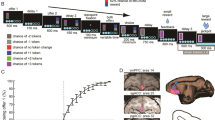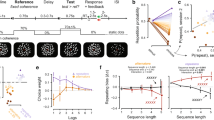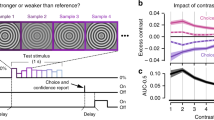Abstract
Simple perceptual tasks have laid the groundwork for understanding the neurobiology of decision-making. Here, we examined this foundation to explain how decision-making circuitry adjusts in the face of a more difficult task. We measured behavioral and physiological responses of monkeys on a two- and four-choice direction-discrimination decision task. For both tasks, firing rates in the lateral intraparietal area appeared to reflect the accumulation of evidence for or against each choice. Evidence accumulation began at a lower firing rate for the four-choice task, but reached a common level by the end of the decision process. The larger excursion suggests that the subjects required more evidence before making a choice. Furthermore, on both tasks, we observed a time-dependent rise in firing rates that may impose a deadline for deciding. These physiological observations constitute an effective strategy for handling increased task difficulty. The differences appear to explain subjects' accuracy and reaction times.
This is a preview of subscription content, access via your institution
Access options
Subscribe to this journal
Receive 12 print issues and online access
$209.00 per year
only $17.42 per issue
Buy this article
- Purchase on Springer Link
- Instant access to full article PDF
Prices may be subject to local taxes which are calculated during checkout







Similar content being viewed by others
Change history
17 June 2008
In the version of this article initially published, the panels in Figure 1 were mislabeled. The correct legend should be ‘Psychometric functions for the 29 experiments that included the 90° control are shown in e. Chronometric functions are shown in f ’. This error has been corrected in the HTML and PDF versions of the article.
References
Gold, J.I. & Shadlen, M.N. The neural basis of decision making. Annu. Rev. Neurosci. 30, 535–574 (2007).
Roitman, J.D. & Shadlen, M.N. Response of neurons in the lateral intraparietal area during a combined visual discrimination reaction time task. J. Neurosci. 22, 9475–9489 (2002).
Palmer, J., Huk, A.C. & Shadlen, M.N. The effect of stimulus strength on the speed and accuracy of a perceptual decision. J. Vis. 5, 376–404 (2005).
Link, S.W. & Heath, R.A. A sequential theory of psychological discrimination. Psychometrika 40, 77–105 (1975).
Laming, D.R.J. Information Theory of Choice-Reaction Times (Wiley, New York, 1968).
Mazurek, M.E., Roitman, J.D., Ditterich, J. & Shadlen, M.N. A role for neural integrators in perceptual decision making. Cereb. Cortex 13, 1257–1269 (2003).
Shadlen, M.N. & Newsome, W.T. Neural basis of a perceptual decision in the parietal cortex (area LIP) of the rhesus monkey. J. Neurophysiol. 86, 1916–1936 (2001).
Hanks, T.D., Ditterich, J. & Shadlen, M.N. Microstimulation of macaque area LIP affects decision-making in a motion discrimination task. Nat. Neurosci. 9, 682–689 (2006).
Huk, A.C. & Shadlen, M.N. Neural activity in macaque parietal cortex reflects temporal integration of visual motion signals during perceptual decision making. J. Neurosci. 25, 10420–10436 (2005).
Hick, W.E. On the rate of gain of information. Q. J. Exp. Psychol. 4, 11–26 (1952).
Lewis, J.W. & Van Essen, D.C. Corticocortical connections of visual, sensorimotor and multimodal processing areas in the parietal lobe of the macaque monkey. J. Comp. Neurol. 428, 112–137 (2000).
Leon, M.I. & Shadlen, M.N. Representation of time by neurons in the posterior parietal cortex of the macaque. Neuron 38, 317–327 (2003).
Sato, T. & Schall, J.D. Pre-excitatory pause in frontal eye field responses. Exp. Brain Res. 139, 53–58 (2001).
Kiani, R., Hanks, T.D. & Shadlen, M.N. Bounded integration in parietal cortex underlies decisions even when viewing duration is dictated by the environment. J. Neurosci. 28, 3017–3029 (2008).
Cook, E.P. & Maunsell, J.H. Dynamics of neuronal responses in macaque MT and VIP during motion detection. Nat. Neurosci. 5, 985–994 (2002).
Ratcliff, R. et al. Dual diffusion model for single-cell recording data from the superior colliculus in a brightness-discrimination task. J. Neurophysiol. 97, 1756–1774 (2007).
Reddi, B.A. & Carpenter, R.H. The influence of urgency on decision time. Nat. Neurosci. 3, 827–830 (2000).
Reddi, B.A., Asrress, K.N. & Carpenter, R.H. Accuracy, information, and response time in a saccadic decision task. J. Neurophysiol. 90, 3538–35346 (2003).
Hanes, D.P. & Schall, J.D. Neural control of voluntary movement initiation. Science 274, 427–430 (1996).
Vickers, D. Decision Processes in Visual Perception (Academic Press, London, 1979).
Ditterich, J., Mazurek, M.E. & Shadlen, M.N. Microstimulation of visual cortex affects the speed of perceptual decisions. Nat. Neurosci. 6, 891–898 (2003).
Jazayeri, M. & Movshon, J.A. A new perceptual illusion reveals mechanisms of sensory decoding. Nature 446, 912–915 (2007).
Purushothaman, G. & Bradley, D.C. Neural population code for fine perceptual decisions in area MT. Nat. Neurosci. 8, 99–106 (2005).
Churchland, A.K. et al. Directional anisotropies reveal a functional segregation of visual motion processing for perception and action. Neuron 37, 1001–1011 (2003).
Ratcliff, R. & Rouder, J.N. Modeling response times for two-choice decisions. Psychol. Sci. 9, 347–356 (1998).
Luce, R.D. Response Times: Their Role in Inferring Elementary Mental Organization (Oxford University Press, New York, 1986).
Lo, C.C. & Wang, X.J. Cortico-basal ganglia circuit mechanism for a decision threshold in reaction time tasks. Nat. Neurosci. 9, 956–963 (2006).
Usher, M. & McClelland, J.L. The time course of perceptual choice: the leaky, competing accumulator model. Psychol. Rev. 108, 550–592 (2001).
McMillen, T. & Holmes, P. The dynamics of choice among multiple alternatives. J. Math. Psychol. 50, 30–57 (2006).
Basso, M.A. & Wurtz, R.H. Modulation of neuronal activity in superior colliculus by changes in target probability. J. Neurosci. 18, 7519–7534 (1998).
Platt, M.L. & Glimcher, P.W. Response fields of intraparietal neurons quantified with multiple saccadic targets. Exp. Brain Res. 121, 65–75 (1998).
Ben Hamed, S., Duhamel, J.R., Bremmer, F. & Graf, W. Visual receptive field modulation in the lateral intraparietal area during attentive fixation and free gaze. Cereb. Cortex 12, 234–245 (2002).
Janssen, P. & Shadlen, M.N. A representation of the hazard rate of elapsed time in macaque area LIP. Nat. Neurosci. 8, 234–241 (2005).
Brody, C.D., Hernandez, A., Zainos, A. & Romo, R. Timing and neural encoding of somatosensory parametric working memory in macaque prefrontal cortex. Cereb. Cortex 13, 1196–1207 (2003).
Maimon, G. & Assad, J.A. A cognitive signal for the proactive timing of action in macaque LIP. Nat. Neurosci. 9, 948–955 (2006).
Ditterich, J. Stochastic models of decisions about motion direction: behavior and physiology. Neural Netw. 19, 981–1012 (2006).
Niwa, M. & Ditterich, J. Perceptual decisions between multiple directions of visual motion. J. Neurosci. 28, 4435–4445 (2008).
Salzman, C.D. & Newsome, W.T. Neural mechanisms for forming a perceptual decision. Science 264, 231–237 (1994).
Bogacz, R., Usher, M., Zhang, J. & McClelland, J.L. Extending a biologically inspired model of choice: multi-alternatives, nonlinearity and value-based multidimensional choice. Philos. Trans. R Soc. Lond. B Biol. Sci. 362, 1655–1670 (2007).
Nichols, M.J. & Newsome, W.T. Middle temporal visual area microstimulation influences veridical judgments of motion direction. J. Neurosci. 22, 9530–9540 (2002).
Ma, W.J., Beck, J.M., Latham, P.E. & Pouget, A. Bayesian inference with probabilistic population codes. Nat. Neurosci. 9, 1432–1438 (2006).
Brainard, D.H. The psychophysics toolbox. Spat. Vis. 10, 433–436 (1997).
Britten, K.H., Shadlen, M.N., Newsome, W.T. & Movshon, J.A. The analysis of visual motion: a comparison of neuronal and psychophysical performance. J. Neurosci. 12, 4745–4765 (1992).
Van Essen, D.C. Surface-based approaches to spatial localization and registration in primate cerebral cortex. Neuroimage 23 Suppl 1: S97–107 (2004).
Gnadt, J.W. & Andersen, R.A. Memory related motor planning activity in posterior parietal cortex of macaque. Exp. Brain Res. 70, 216–220 (1988).
Thier, P. & Andersen, R.A. Electrical microstimulation suggests two different forms of representation of head-centered space in the intraparietal sulcus of rhesus monkeys. Proc. Natl. Acad. Sci. USA 93, 4962–4967 (1996).
Judge, S.J., Richmond, B.J. & Chu, F.C. Implantation of magnetic search coils for measurement of eye position: an improved method. Vision Res. 20, 535–538 (1980).
Arai, K., McPeek, R.M. & Keller, E.L. Properties of saccadic responses in monkey when multiple competing visual stimuli are present. J. Neurophysiol. 91, 890–900 (2004).
Walker, R., Deubel, H., Schneider, W.X. & Findlay, J.M. Effect of remote distractors on saccade programming: evidence for an extended fixation zone. J. Neurophysiol. 78, 1108–1119 (1997).
Risken, H. The Fokker-Planck Equation: Methods of Solutions and Applications (Springer, New York, 1989).
Acknowledgements
We thank A. Boulet, C. Lea, M. Mihali and K. Skypeck for technical assistance. This work was supported by the US National Institutes of Health (EY011378 and RR00166) and the Howard Hughes Medical Institute.
Author information
Authors and Affiliations
Corresponding author
Supplementary information
Supplementary Text and Figures
Supplementary Figures 1–8 (PDF 642 kb)
Rights and permissions
About this article
Cite this article
Churchland, A., Kiani, R. & Shadlen, M. Decision-making with multiple alternatives. Nat Neurosci 11, 693–702 (2008). https://doi.org/10.1038/nn.2123
Received:
Accepted:
Published:
Issue Date:
DOI: https://doi.org/10.1038/nn.2123
This article is cited by
-
Electrophysiological population dynamics reveal context dependencies during decision making in human frontal cortex
Nature Communications (2023)
-
Choice selective inhibition drives stability and competition in decision circuits
Nature Communications (2023)
-
The archerfish predictive C-start
Journal of Comparative Physiology A (2023)
-
Deep imagination is a close to optimal policy for planning in large decision trees under limited resources
Scientific Reports (2022)
-
The effect of fatigue on electromechanical response times in basketball players with and without persistent low back pain
Scientific Reports (2022)



